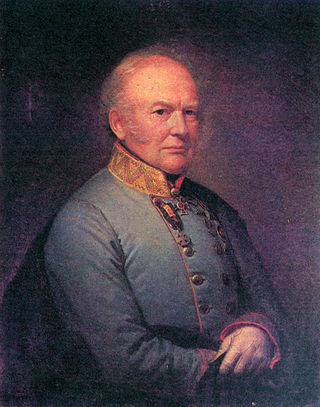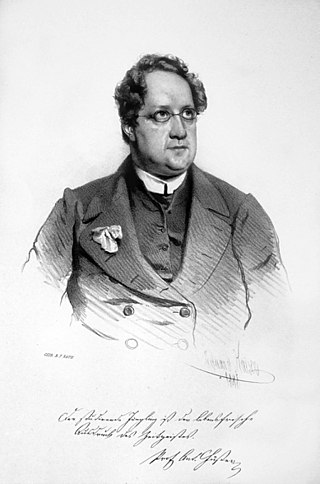
Klemens Wenzel Nepomuk Lothar, Prince of Metternich-Winneburg zu Beilstein, known as Klemens von Metternich or Prince Metternich, was a conservative Austrian statesman and diplomat who was at the center of the European balance of power known as the Concert of Europe for three decades as the Austrian Empire's foreign minister from 1809 and Chancellor from 1821 until the liberal Revolutions of 1848 forced his resignation.

The Austrian Empire, officially known as the Empire of Austria, was a multinational European great power from 1804 to 1867, created by proclamation out of the realms of the Habsburgs. During its existence, it was the third most populous monarchy in Europe after the Russian Empire and the United Kingdom. Along with Prussia, it was one of the two major powers of the German Confederation. Geographically, it was the third-largest empire in Europe after the Russian Empire and the First French Empire.

The Revolutions of 1848 in the Austrian Empire were a set of revolutions that took place in the Austrian Empire from March 1848 to November 1849. Much of the revolutionary activity had a nationalist character: the Empire, ruled from Vienna, included ethnic Germans, Hungarians, Poles, Bohemians (Czechs), Ruthenians (Ukrainians), Slovenes, Slovaks, Romanians, Croats, Italians, and Serbs; all of whom attempted in the course of the revolution to either achieve autonomy, independence, or even hegemony over other nationalities. The nationalist picture was further complicated by the simultaneous events in the German states, which moved toward greater German national unity.

The German revolutions of 1848–1849, the opening phase of which was also called the March Revolution, were initially part of the Revolutions of 1848 that broke out in many European countries. They were a series of loosely coordinated protests and rebellions in the states of the German Confederation, including the Austrian Empire. The revolutions, which stressed pan-Germanism, demonstrated popular discontent with the traditional, largely autocratic political structure of the thirty-nine independent states of the Confederation that inherited the German territory of the former Holy Roman Empire after its dismantlement as a result of the Napoleonic Wars. This process began in the mid-1840s.

The Vienna Uprising or October Revolution of October 1848 was the last uprising in the Austrian Revolution of 1848.

Felix Ludwig Johann Friedrich, Prince of Schwarzenberg was a Bohemian nobleman and an Austrian statesman who restored the Austrian Empire as a European great power following the Revolutions of 1848. He served as Minister-President of the Austrian Empire and Foreign Minister of the Austrian Empire from 1848 to 1852.

Alexander Schimmelfennig was a Prussian soldier and political revolutionary. After the German revolutions of 1848–1849, he immigrated to the United States, where he served as a Union Army general in the American Civil War.

The Hungarian Revolution of 1848, also known in Hungary as Hungarian Revolution and War of Independence of 1848–1849 was one of many European Revolutions of 1848 and was closely linked to other revolutions of 1848 in the Habsburg areas. Although the revolution failed, it is one of the most significant events in Hungary's modern history, forming the cornerstone of modern Hungarian national identity—the anniversary of the Revolution's outbreak, 15 March, is one of Hungary's three national holidays.

The revolutions of 1848, known in some countries as the Springtime of the Peoples or the Springtime of Nations, were a series of revolutions throughout Europe over the course of more than one year, from 1848 to 1849. It remains the most widespread revolutionary wave in European history to date.

Louis Blenker was a German revolutionary and American soldier.

Karl Wilhelm Philipp, 8th Prince of Auersperg, Duke of Gottschee was a Bohemian and an Austrian nobleman and statesman. He served as the first President of the Austrian House of Lords and as the first prime minister of the western part of the Austro-Hungarian Empire (Cisleithania).

Karl Ludwig, Count of Ficquelmont was an Austrian aristocrat, statesman and Field marshal of the Austrian Imperial army of French noble origin.

The Ministry of Foreign Affairs is the government ministry of Austria responsible for diplomatic missions and immigration, the administration of foreign policy, and the maintenance of the country's relations with international organisations, especially the European Union. It oversees the Austrian embassies, consular representatives and other emissaries, and administers the naturalisation process and handles citizenship questions along with the Interior Ministry.

Baron Franz Xaver von Pillersdorf was an Austrian statesman.

Count Franz Philipp von Lamberg was an Austrian soldier, statesman, journalist and writer, who held the military rank of field marshal. He had a short but important role in the Hungarian Revolution of 1848.

Theodor Franz, Count of Baillet von Latour was an Austrian soldier and statesman. As the Imperial Minister of War, he was killed by a mob at the beginning of the Vienna Uprising.

Anton Füster, also spelled as Fister was an Austrian Roman Catholic priest, theologian, pedagogue, radical political activist and author of Slovene origin. He was one of the leaders of the Viennese March Revolution of 1848.

Count Maximilian Anton Karl Baillet de Latour was an Austrian general during the French Revolutionary Wars.

The Slovak Uprising , Slovak Volunteer Campaigns or Slovak Revolt was an uprising of Slovaks in Western parts of Upper Hungary with the aim of equalizing Slovaks, democratizing political life and achieving social justice within the 1848–49 revolutions in the Habsburg Monarchy. It lasted from September 1848 to November 1849. In October 1848, Slovak leaders replaced their original Hungaro-federal program by Austro-federal, called for the separation of a Slovak district from the Kingdom of Hungary and for the formation of a new autonomous district within the framework of the Habsburg Monarchy.

The Serb uprising of 1848–49, also known as the Serb revolution of 1848–49 and Serb People's Movement of 1848–49, took place in what is today Vojvodina, Serbia, and was part of the Revolutions of 1848 in the Austrian Empire. During the Hungarian Revolution, Hungarians achieved significant military successes, but were defeated after Russian intervention. Serbs led fierce battles against the Hungarians for autonomy or merge with the help of volunteers from the Principality of Serbia. The outcome of the uprising was the establishment of Serbian Vojvodina, a special autonomous region under the Austrian crown. However, the Voivodeship failed certain expectations that Serbian patriots had expressed at the May Assembly (1848). Serbs did not constitute an absolute majority of the population, while the administration was largely in the hands of German officials and officers. The Voivodeship was abolished in 1860, however, some rights were kept by the Serb community. The Serbian Patriarchate was renewed, while the uprising had increased national awareness of the Serb people north of the Sava and Danube in the struggle for freedom.



















